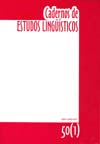Resumo
The aim of this work is to investigate the movements subjacent to the act of the erasure produced by pairs of students in the scholar context when they were discussing and writing a made-up story. In this work, the focused erasures attested the presence of the equivocalness as a language constitutive and the sense produced thereby. The methodological procedure of data collection consisted in filming a pair of students from the moment in which they discussed an invented a story to the moment of writing and concluding it. The registers named by Lacan as Real, Symbolic and Imaginary revealed themselves to be essential in the development of this work, since they combine unconsciousness, subjecthood, language and discourse. This work shows that the erasure is not, in spite of the student’s intentions, an instrument of “correction”. We show that the erasures made by the students point to a movement that searches for the similarity, for the recognition between what is said/written and what “should” be said/written. However, the “listening” effect of this recognition does not flow in the same direction, because there are erasure cases that encompass not only the “listening” but also what here is named “equivocal-listening”: the student, when searching for similarity, the unity of chunks of language, sometimes erases what is already “correct”, producing in this way an ambiguity/equivocalness.Referências
ARRIVE, M. (1999). Linguagem e Psicanálise, Lingüística e Inconsciente. Freud, Saussure, Pichon, Lacan. Rio de Janeiro: Jorge Zahar Editor.
CALIL, E. (1998). Autoria: a criança e a escrita de histórias inventadas. Maceió: Editora da Universidade Federal de Alagoas.
CALIL, E. (1999). “História inventada relações entre (im)previsível e rasura”. Manuscrítica, 8. São Paulo: Annablume. (209 - 220) (ISSN 1415-4498).
CALIL, E. (2003) “Processus de création et ratures: analyse d’un processus d’écriture dans un texte redige par deux écolières”. Langage & Societé, p. 31-55. Paris: Maison des Sciences de L’homme.
FELIPETO, S. C. S. (2003). Rasuras entre o oral e o escrito: o equívoco na altercação. Tese de doutoramento. Ufal, inédita.
FREUD, S. (1969). “O estranho”. A Edição Eletrônica Brasileira das Obras Psicológicas Completas de Sigmund Freud. Rio de Janeiro: Imago editora.
LACAN, J. ([1972-73]1985). Seminário XX, Mais Ainda. Rio de Janeiro: Jorge Zahar Editora.
LEMOS, C. T. G. de. (1991). Saber a língua e o saber da língua. Campinas: Aula inaugural.
LEMOS, C. T. G. de. (1995). “Corpo e Linguagem”. Corpo - mente: uma fronteira móvel. São Paulo: Editora Casa do Psicólogo.
LEMOS, C. T. G. (1999). Relatório (CNPq). Campinas: IEL/Unicamp (Mimeo).
LEMOS, M. T. (1994). A Língua que me falta: uma análise dos estudos em Aquisição de Linguagem. Tese de doutorado. IEL/Unicamp.
LIER DE VITTO, M. F. & FONSECA, S. C. da. (1998). “Reformulação ou ressignificação?” Cadernos de Estudos Lingüísticos, 33 (51 - 60) Campinas: IEL/Unicamp.
MILNER, J-C. (1987). O amor da língua. Porto Alegre: Artes Médicas.
MILNER, J-C. (1989). Introduction à une science du langage. Paris: Ed. du Seuil.
MILNER, J-C. (2002). Le Périple structural: figures et paradigme. Paris: Ed. de Seuil.
NOVAES, M. (1996). Os dizeres nas esquizofrenias: uma cartola sem fundo. São Paulo: Escuta.
SAUSSURE, F. de. ([1916]1995). Curso de Lingüística Geral. São Paulo: Cultrix.
WILLEMART, P. (1991). A rasura, senha de entrada no mistério da criação. Caderno de Textos – Crítica Genética, 5. João Pessoa: UFPB.
WILLEMART, P. (1996). “Do sentido ao corpo: a rasura”. Corpo e sentido. S. Paulo: Ed. da Unesp, p. 155-152.
WILLEMART, P. (2002). “Como se constitui a escritura literária?”. Criação em Processo: ensaios de crítica genética. S. Paulo: Ed. Iluminuras Ltda, p. 73-93.
O periódico Cadernos de Estudos Linguísticos utiliza a licença do Creative Commons (CC), preservando assim, a integridade dos artigos em ambiente de acesso aberto.

